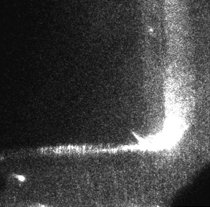Physics turns a corner with three-point turn atoms

You may think making a three-point turn in your car is easy, but how about doing the same with a single-charged atom?
That's what scientists have achieved for the first time, marking a major breakthrough for physics and a first step towards creating the complicated labyrinth of 'atomic motorways' needed for a quantum computer.
The microscopic motoring manoeuvre was performed by University of Sussex physicist Dr Winfried Hensinger with colleagues at the University of Michigan, USA. Details of the experiment are published in the January 2006 issue of the journal Applied Physics Letters.
The ability to shuttle ions (charged atoms) in a controlled environment is seen as an important demonstration of how to harness the seemingly magical properties of atoms. This development will help scientists to store and analyse the vast quantities of data used in highly sophisticated calculations - in super-fast quantum computers.
To be able to build this kind of computer, scientists need to trap ions - no mean feat in itself - then control their movements in a sophisticated labyrinth of 'atomic roads'. Such a process has previously been carried out for single ions along one line, but Dr Hensinger (now Lecturer in Atomic Molecular and Optical Physics at Sussex), and the Michigan team have shown how they can make atoms turn a corner.
Keen for more driving pleasure, they even managed to switch two ions around by having them perform a three-point turn. This will hopefully allow eventually for the mass-manipulation of atoms, vital for the operation of a quantum computer.
Ion traps are made from micro-fabricated electrodes, in which ions are controlled by electric fields in an ultra-high vacuum chamber. The new construction, the first two-dimensional ion trap array, is the most sophisticated yet. The ions are steered inside a T-junction that is laser micro-machined in thin layers of a material called alumina.
Dr Hensinger says: "This is big news because it is very difficult to trap atoms, let alone manipulate them in transit. This and other recent developments show that it should be possible to build a quantum computer with trapped ions. Now we can take two atoms and swap them around, which mathematically corresponds to a fundamental requirement for a quantum computer. This is the prerequisite to go from something academically interesting to something useful. This is a quantum leap in the development of the quantum computer."
Quantum technology could be used in the future to understand chemical reactions, create medicines, ultra-fast communications systems and seemingly impossible simulations, such as the creation of our universe.
Source: University of Sussex

















